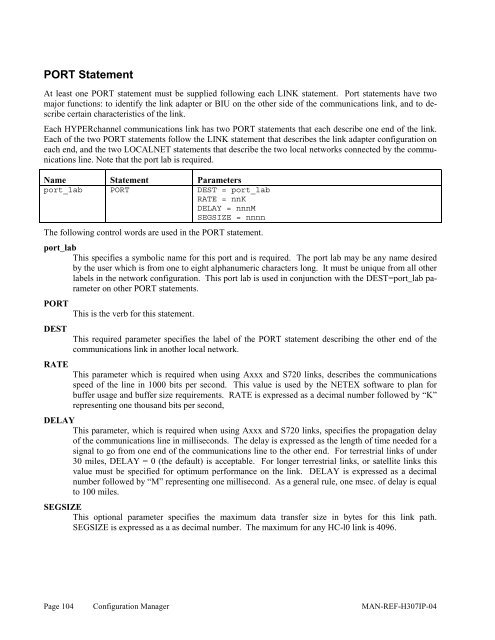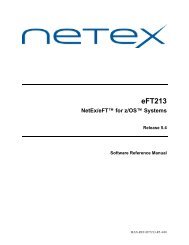SDISC Assembler Call - NetEx
SDISC Assembler Call - NetEx
SDISC Assembler Call - NetEx
- No tags were found...
You also want an ePaper? Increase the reach of your titles
YUMPU automatically turns print PDFs into web optimized ePapers that Google loves.
PORT StatementAt least one PORT statement must be supplied following each LINK statement. Port statements have twomajor functions: to identify the link adapter or BIU on the other side of the communications link, and to describecertain characteristics of the link.Each HYPERchannel communications link has two PORT statements that each describe one end of the link.Each of the two PORT statements follow the LINK statement that describes the link adapter configuration oneach end, and the two LOCALNET statements that describe the two local networks connected by the communicationsline. Note that the port lab is required.Name Statement Parametersport_lab PORT DEST = port_labRATE = nnKDELAY = nnnMSEGSIZE = nnnnThe following control words are used in the PORT statement.port_labThis specifies a symbolic name for this port and is required. The port lab may be any name desiredby the user which is from one to eight alphanumeric characters long. It must be unique from all otherlabels in the network configuration. This port lab is used in conjunction with the DEST=port_lab parameteron other PORT statements.PORTThis is the verb for this statement.DESTThis required parameter specifies the label of the PORT statement describing the other end of thecommunications link in another local network.RATEThis parameter which is required when using Axxx and S720 links, describes the communicationsspeed of the line in 1000 bits per second. This value is used by the NETEX software to plan forbuffer usage and buffer size requirements. RATE is expressed as a decimal number followed by “K”representing one thousand bits per second,DELAYThis parameter, which is required when using Axxx and S720 links, specifies the propagation delayof the communications line in milliseconds. The delay is expressed as the length of time needed for asignal to go from one end of the communications line to the other end. For terrestrial links of under30 miles, DELAY = 0 (the default) is acceptable. For longer terrestrial links, or satellite links thisvalue must be specified for optimum performance on the link. DELAY is expressed as a decimalnumber followed by “M” representing one millisecond. As a general rule, one msec. of delay is equalto 100 miles.SEGSIZEThis optional parameter specifies the maximum data transfer size in bytes for this link path.SEGSIZE is expressed as a as decimal number. The maximum for any HC-l0 link is 4096.Page 104 Configuration Manager MAN-REF-H307IP-04















